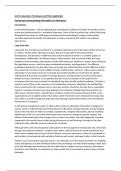Unit 4: Laboratory Techniques and Their Application
Storing and communicating information in a laboratory.
Introduction
In the following report, I will be exploring and evaluating how different scientific information can be
stored and communicated in a workplace laboratory. Some of the key points that I will be discussing
throughout this report are challenges in storing and communicating the range of information
recorded and processed within the laboratory as well as comparing the systems in workplace
laboratories.
Large Data Sets
Large data sets are often accumulated in a workplace laboratory due to the large number of surveys
or studies, which contain abundance of data, that are conducted for the improvement,
development, and discovery of different factors that would be involved in a scientific project or
investigation. Additionally, the different types of information’s that are stored within the large
databases of the workplace laboratories include DNA sequences, healthcare records, data relating to
the population surveys, which has been mentioned previously, and fingerprints. The different
workplace laboratories can also often have very large sets of data kept due to their different policies
that causes them to keep record of different types of information. However, other reasons why the
information’s have been stored are to provide personalised healthcare treatments for specific
individuals that have been included in the large datasets, checking what research has been done
already to ensure that there is no repetition but also for the evaluation of the quality of the
treatments that have been provided to individuals that have specific medical conditions. The data is
saved on several files on the computer or be handwritten. However, oftentimes, the handwritten
data is inserted into the computer since it increases security. Overtime, the data that is repeatedly
saved on computers because very large leading to the computer holding large data sets that can
often cause confusion when a specific piece of data is needed to be found. Because of this, many
organisations have installed systems that allows useful information to be obtained from large data
sets, which can easily manage the large data sets allowing required information to be immediately
found when it is required.
A well-known management system is LIMS, which stands for laboratory information management
system, which is software that permits businesses to effectively manage large data sets by keeping
track of the data that are linked to samples, experiments, integrate instruments, and lab workflow.
Additionally, LIMS can track information about who carried out changes to specific samples and
different information about the changes such as when it was done, how they happened, and what
happened to the specific piece of data during the process as well tracking it through all the time
making the data collection process much easier and faster.
Although LIMS is the most frequently used system for the management of large data sets, other data
storage and collection software’s could be used, where some of them are normal repositories into
where data is added whereas some of the software’s are more advanced, so they are automated as
well as able to communicate with varieties of devices and convert and export data to other formats.
Another way of storing the large data sets in a way that they are easily found is printers for weighing
scales and balances as some individuals believe that technology can often break leading to their data
to be lost although most businesses do store their data in a paper form too, however, they believe
that this is more efficient as computers are often unable to be connected to scales as they could be
damaged.




